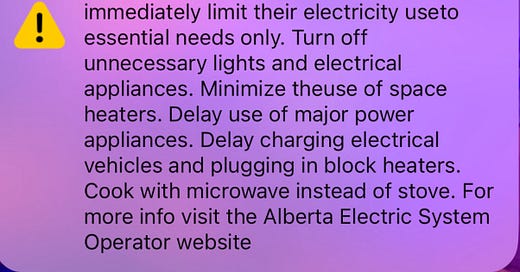Freezing in the dark just got real.
Last night’s grid emergency shows just how ill-thought-out the Liberal electrification regulations really are.
Last night, as temperatures plummeted to below -40C, an emergency alert was delivered to every phone in Alberta. The message? Use as little electricity as possible.
As the energy demand to keep dwellings warm spiked on the coldest night of the year, the Alberta Energy System Operator - the entity in charge of managing the province's power grid - channelled Star Trek’s Montgomery Scott and told Albertans that the grid was giving all it had: any more demand and outages could occur on the coldest night of the year.
This real-life example of what happens when a jurisdiction's electrical generation and distribution system cannot keep up with demand hit home a truth for millions of Canadians that seems to have escaped Prime Minister Justin Trudeau and his Environment Minister Stephen Guilbeaut. If Canada's aging electric system is already buckling under peak demand, it isn't likely able to handle further extreme demand created by Liberal regulations and programs that also potentially reduce supply.
And as last night in Alberta demonstrated, having no plan to first address these issues is a huge problem for the entire country.
The examples of this lack of foresight are legion. For starters, the Liberals recently went to great lengths to promote using heat pumps for home heating. However, during periods of sustained cold, many heat pumps become ineffective and require electric backup systems, which strain the grid during the least opportune moments, like extreme cold weather peak demand.
Even more of an issue in this regard are the Liberal's electric vehicle regulations, which aim to pull all gas-powered passenger vehicles off the road in a scant ten year time frame. Stateline states, "the average electric vehicle requires 30 kilowatt-hours to travel 100 miles — the same amount of electricity an average home uses daily to run appliances, computers, lights and heating and air conditioning". Canada currently has about 26 million passenger vehicles, which is likely to grow as government fails to build functional public transit continue while population numbers surge through immigration. It doesn't take a genius to figure out that it will be lights out for Canada if the Liberals push forward with no plans to dramatically, and functionally, increase electricity supply by the time their regs fully come into force.
Worse, the Liberals concurrently announced net-zero electricity generation regulations that could actually reduce electricity supply in parts of Canada where limited capacity for things like hydroelectric generation mean natural gas electric generation is necessary. There is no evidence to suggest that lower output and intermittently producing renewable sources of generation, like wind and solar, could replace current generating capacity in these parts of Canada in the period the regulations are supposed to come into force at all, never mind without passing an astronomical cost increase to consumers. The same fact also could significantly impact the reliability of the power generation system, harming many aspects of civil society and the economy.
Further, expecting these parts of Canada to move to different forms of electric generation in such a short period without the feds showing full-throated support for consistently reliable, high-output generation methods like nuclear power and massive injections in federal cash to build it means there could be less power generated, not more, just as the Liberal’s electric vehicle regulations, a rapidly increasing population and the need to grow a faltering economy put more demand on the system.
And even if Canada could generate enough electricity to meet this demand, other problems would also need to be fixed too. The infrastructure of Canada's power distribution systems - power transmission lines, for example - may need help carrying this increased load. I've spent many a dinner discussing this problem with a well-known expert in the field of load research (shout out to my dad), who boils the challenge of electrifying a cold weather climate like Canada that's reliant on natural gas for heating down to this: policymakers can't expect the energy currently transmitted via gas pipeline to be transferred onto the electric transmission system without a significant amount of planning.
Think of it this way. Just like a consumer attempting to run too many high power consuming appliances off of one circuit can cause electrical wires to melt without a failsafe, policymakers shouldn't expect to rapidly add load to power lines without carefully calculating the strain on the system and building out new capacity. Think of an elevator with too many passengers - it can't safely function under the strain without additional cables to support the load.
Cost of building and environmental regulations for where power lines can be built are complex challenges that need to be addressed to add more capacity to Canada’s system. Then consider that critical electric distribution infrastructure lies underground in urban commercial and residential areas, and things get even more complicated. These problems will have a big impact on Canada's urban areas, which means rural regions and remote First Nations communities that are already underserviced could face even greater challenges.
None of this says that electrifying Canada over time isn't a laudable goal. However, that Mr. Trudeau and Mr. Guilbeault are pressing forward on their present regulatory regime with sweet fudge all for a plan to address these challenges first is not only delusional but also gravely irresponsible.
But remember - Mr. Trudeau has friends in warm places. So maybe all these ill-thought-out regulations mean he's just happy to let all of us plebeian bastards freeze in the dark.
Stay warm, friends.




